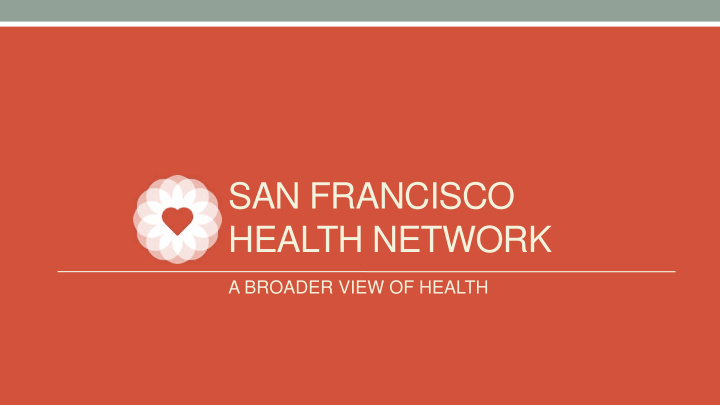



SAN FRANCISCO HEALTH NETWORK A BROADER VIEW OF HEALTH
Next 30 Minutes • Trends • San Francisco • Poverty as driver • Where do we go from here?
Boston 1999
Current Trends Pubmed search for “social determinants” * * 1999 2013
Healthcare and…
San Francisco’s Track Record
Department of Public Health Health Commission Organizational Chart Director of Health Policy & Human Information Interdivisional Compliance & Finance Security Communications Planning Resources Technology Initiatives Privacy Affairs Community Health Managed Care Ambulatory Care Environmental Health Equity & Promotion Disease Prevention & Public Health Emergency Zuckerberg San Francisco Control Preparedness & Response Primary Care General Hospital Emergency Medical Office of Equity & Behavioral Health Services Quality Laguna Honda Hospital Office of Ops, Finance Center for Learning & Transitions and & Grants Mgmt. Innovation Jail Health SF Behavioral Health Center Applied Research, Center for Public Health Community Health Maternal, Child & Research Epidemiology & Surveillance Adolescent Health Bridge HIV
race/ethnicity SFHN MISSION San Francisco 6 15 35 41 We provide high quality health care that enables all San Franciscans to live vibrant, healthy lives. SFHN 17 28 23 23 0% 20% 40% 60% 80% 100% Black Latino Asian White Other insurance San Francisco 18 15 7 SFHN 59 10 10 0% 20% 40% 60% 80% 100% Medicaid Medicare Uninsured Other
Social Medicine in the ED AS: 89 year old woman originally from Australia. Living on BART, riding in her wheelchair all day, getting off at night to stay on street. Frequent incontinence, leading to 911 calls, escorted by BART police to local EDs. 60 ED visits at ZSFG alone in 12 months prior to intervention. February 2018 ED found to have pressure ulcers, had not bathed in months. Social medicine team elicited her priorities: hunger, painful bottom, concern for belongings being lost or stolen. Moved indoors that evening, sheltered since. Now clean, well nourished, healed skin. Has ID, applied for entitlements and insurance, looking into longer term residential housing.
Social Medicine in the ED PDSA Start • Many ZSFG ED patients have ED Pharmacy Meds in Hand Program 8/17 high medical and social needs. Care Plan Documentation in ED 10/17 Information Exchange (EDIE) • ED volume and pace limit ability to address complex needs, Transitions (to Hummingbird, 10/17 transitional housing, respite) resulting in repeat ED visits or admissions for low medical/high ED MD/NP-SW Multi-Disciplinary 11/17 Rounds social acuity. Engagement of ED Utilization 11/17 • Multipronged initiative developed Management RN to decrease short stay “social ED Patient Care Coordinator 1/18 admissions” by 50% from 550 to Social Medicine Consult Service 1/18 275 within one year. Social Needs Screening Tool 1/18 Slide adapted from Jack Chase and Hemal Kanzaria
Social Medicine in the ED Transitions team provides complex care management and residential care at shelters, SFHN SRO hotels and navigation centers. Transitions Social MD supports ED team with content expertise, incorporating biomedical, Social mental health, addiction medicine, and Medicine MD community-based social support elements into treatment plans. ED multidisciplinary team Patient care coordinator (PCC) serves as connector between patient, ED (MD/NP, PCC, SW, UM, team and outpatient resources. Pharmacy) Slide adapted from Jack Chase and Hemal Kanzaria
Social Medicine in the ED Slide courtesy of Jack Chase and Hemal Kanzaria
Poverty as Driver healthcare
Historical Side Note • Poverty thresholds developed in 1963. • Based on Department of Agriculture’s “thrifty food plan” which was “designed for temporary or emergency use when funds are low.” • 1955 Household Food Consumption Survey showed average family spent about 1/3 post-tax income on food. If it is not possible to state unequivocally ‘how much is enough,’ it should be possible to assert with confidence how much, on average, is too little.
Poverty: Prevalent, Deep 2016 Poverty Statistics Overall rate: 12.7% Twice FPL: 29.8% Half FPL: 5.8% Child rate: 18% Latino rate: 19% Black rate: 22% N American rate: 26.2%
Poverty: Reified, Racialized San Francisco elementary schools with lowest Academic Performance Index (API) scores ”More than half the Negro population of San Francisco are located here, and it is considered a highly hazardous area.” - 1937 Home Owner’s Loan Corporation Slide adapted from Zea Malawa
How did we get from there to here?
Capturing Complexity, Avoiding Reductionism AS is an 89 female with • Z59.0 homelessness • Z59.5 extreme poverty • Z59.7 insufficient social insurance and welfare support • Z99.3 dependence on wheelchair • L89.3 pressure ulcer of buttock • Z60.4 isolation, social • N39.498 other specified urinary incontinence • Z59.4 lack of adequate food and safe drinking water
Follow the Money
Healthcare is Complicit $1163.3b $59.9b $54.9b $14.8b Bradley EH, Taylor LA. The American Health Care Paradox: Why Spending More is Getting Us Less. 2013.
It’s not really about us… PUBLIC HEALTH SELF MANAGEMENT “ ALTERNATIVE ” MEDICINE ECONOMIC DEVELOPMENT DEFENSE ARTS EDUCATION FOOD ENVIRONMENT HOUSING ADDICTION MENTAL ”PRIMARY CARE” PRIMARY HEALTH CARE HEALTH DEVICES HOSPITALIZATIONS SNFS PLANS SPECIALTY REFERRALS HOSPITALS PHARMA ACADEMIC MEDICAL CENTER Green LA, Yawn BP, Lanier D, Dovey SM. The Ecology of Medical Care Revisited. NEJM 2001; 344(26): 2021-25.
A Path Forward There are nearly 300,000 Medicaid recipients in the North Philadelphia zone… These families are more likely to experience deep poverty that affects not only their health but also their education, employment and income.
Last Thoughts …to whom much is given, much is • Health care’s focus on identifying required. and addressing social needs is absolutely necessary and utterly - John F Kennedy insufficient. The test of our progress is not • We should resist the temptation to whether we add more to the medicalize poverty and social abundance of those who have resource needs. much; it is whether we provide • Do we have the commitment to enough for those who have too health that would logically result little. in shifting money away from - Franklin D Roosevelt health care over time?*
QUESTIONS? alice.chen@sfdph.org
Recommend
More recommend